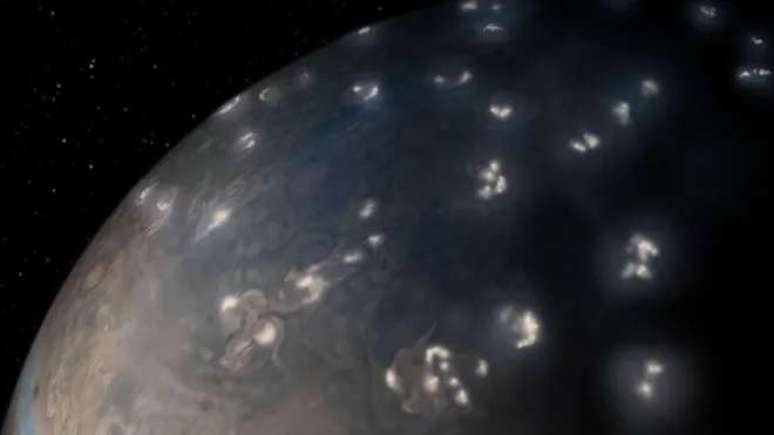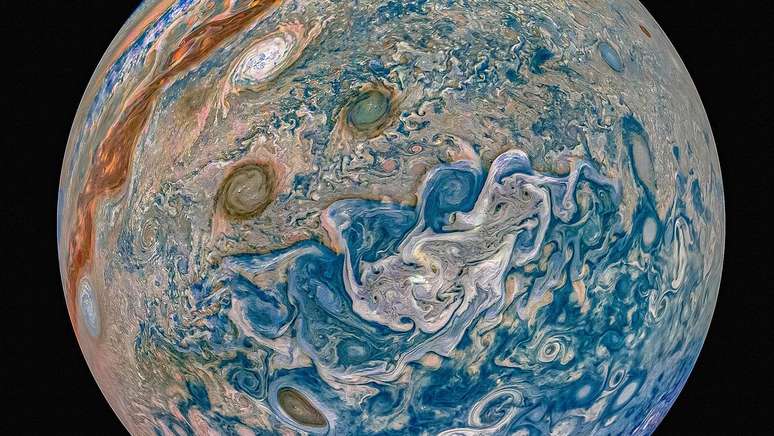The processes that form lightning on Jupiter are similar to those on Earth, according to radio signals picked up by the Juno spacecraft.
The lightning formation processes on Jupiter are very similar to those on Earth, according to the results of a new study published in the journal Nature communications. On the other hand, the conditions necessary for their formation can be very different.
- The movement of the colored bands on Jupiter has to do with the magnetic field
- JUICE | Find out all about the mission that will study the moons of Jupiter
Since the voyage of Voyager 1 to Jupiter more than 40 years ago, astronomers already knew that lightning strikes there with the same frequency as on our planet. Confirmation came when the spacecraft captured weak radio signals, emitted by electric discharge beams.
The presence of these phenomena on Jupiter is not a surprise, as it is covered in thunderclouds, tornadoes and cyclones – in fact, these are the only things we see in photos of the gas giant. However, scientists still had many questions about how lightning processes occur there.
After five years of studying the data of the Juno spacecraft, dedicated exclusively to Jupiter observations since 2016, the authors of the new study found that Jovian rays occur the same way as on Earth, “step by step”. In other words, they produce the same kind of electrical storms.
For this it was necessary to examine the data from the Waves instrument, aboard the Juno spacecraft. Alone, it collected 10 times more radio emissions than previous missions (Voyager 1 and 2, Galileo and Cassini). The waves picked up radio signals up to a millisecond apart, revealing the typical steps in lightning formation.

On Earth, lightning appears to form and light up the sky in a single process, but this isn’t true: There are several distinct, very fast steps, each emitting isolated radio signals. By studying these emissions, scientists can better understand what happens inside the clouds during a thunderstorm.
That is why the authors of the study decided to study Juno’s radio signals, and the result was the detection of the same distinct passages before the electric discharge of lightning. This is enough to conclude that the processes are very similar on the two planets.
Despite this, there are other unanswered mysteries, such as the regions where there is a higher incidence of lightning. On Earth, they occur most frequently in the tropics and at the equator, and very little electrical activity in the clouds at the poles. On Jupiter it’s the exact opposite, and scientists still don’t know why.
The study authors suspect that this difference occurs because the conditions for the formation of the rays are completely different on each planet, even if the processes are the same. Other mysteries include the fact that no lightning has been found in Jupiter’s Great Red Spot.
Source: Nature communications; through: space.com
Trending on Canaltech:
- The best time to drink coffee, according to science
- 10 cool commands to use in ChatGPT
- The 10 best Sentai in history
- Netflix starts charging for account sharing in Brazil
- Toyota Vitz | Meet a popular car that costs less than R $ 50 thousand
- $200 Chinese Mini PC with Intel N100, 12GB RAM, 512GB SSD
Source: Terra
Rose James is a Gossipify movie and series reviewer known for her in-depth analysis and unique perspective on the latest releases. With a background in film studies, she provides engaging and informative reviews, and keeps readers up to date with industry trends and emerging talents.


![Such a wonderful sun in advance: Summary of the Episode of Friday May 9, 2025 [SPOILERS] Such a wonderful sun in advance: Summary of the Episode of Friday May 9, 2025 [SPOILERS]](https://fr.web.img3.acsta.net/img/64/3e/643eee90358f278b5b6ba954f85d645b.png)

